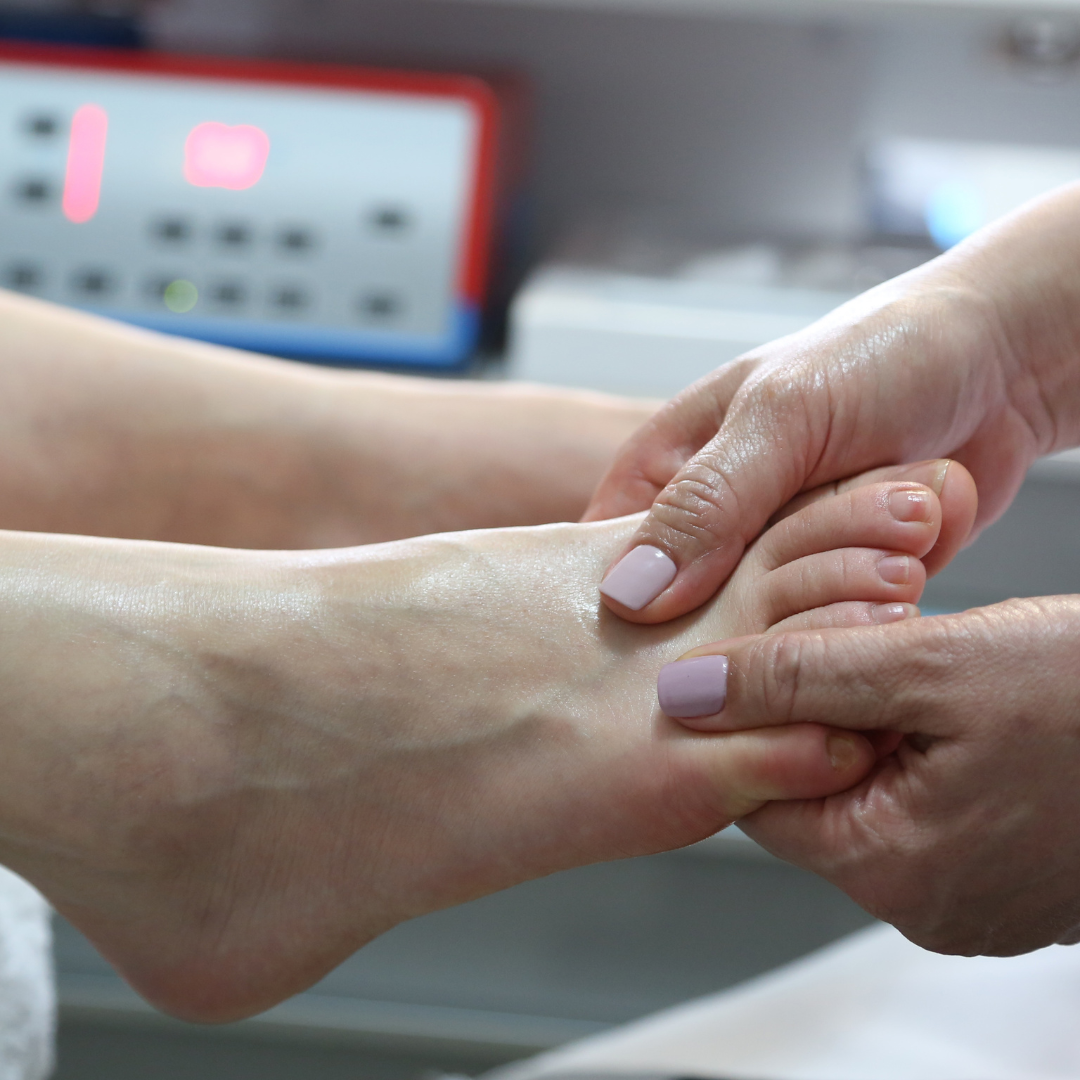Feet. We often don’t think about them until they start giving us trouble. As we age, our feet, the very foundation of our mobility, can begin to experience wear and tear that impacts our overall quality of life. For the elderly, foot health is not just about comfort—it’s about maintaining independence, mobility, and well-being. Let’s explore some common foot problems that affect older adults and how podiatry can step in to help.
Understanding Ageing Feet: The Basics
Feet are complex structures, made up of 26 bones, 33 joints, and more than 100 muscles, tendons, and ligaments. Over a lifetime, they bear the brunt of our body weight, walking us through thousands of miles. But as we age, a number of changes take place:
- Skin changes – Skin becomes thinner, drier, and more fragile, making it prone to cuts, blisters, and infections.
- Circulatory issues – Reduced blood circulation can lead to conditions like peripheral arterial disease (PAD), affecting the feet.
- Joint problems – Arthritis becomes more common, leading to pain, swelling, and deformities.
- Nail changes – Toenails can become thicker, more brittle, and prone to fungal infections.
These changes mean that foot problems can sneak up more easily on older adults, turning minor issues into significant challenges. That’s where podiatry comes into play. So, shall we take a look at some common issues and how podiatry can make a massive difference?
Common Foot Problems in the Elderly
1. Bunions
Bunions are a painful bony bump that forms on the joint at the base of the big toe. They can develop at any age but are more common in older adults due to years of pressure and misalignment. Wearing ill-fitting shoes or a genetic predisposition can exacerbate the problem.
2. Corns and Calluses
Corns and calluses are thickened areas of skin that develop as a result of friction and pressure. While they might seem like a minor annoyance, for elderly individuals with sensitive or thin skin, they can become painful and even lead to ulcers if not properly managed.
3. Plantar Fasciitis
Plantar fasciitis involves inflammation of the band of tissue (the plantar fascia) that runs along the bottom of the foot. This condition often causes stabbing pain in the heel, especially when taking the first steps in the morning. As we age, the plantar fascia can lose elasticity, making it more prone to injury.
4. Diabetic Foot Problems
For older adults with diabetes, foot care becomes even more critical. Diabetes can lead to nerve damage (neuropathy), reducing sensation in the feet. This means that injuries or infections might go unnoticed, leading to more severe complications like ulcers, which can be slow to heal and, in severe cases, lead to amputation.
5. Toenail Fungus
Thick, yellow, and brittle toenails can be a sign of a fungal infection. These infections are not only unsightly but can also cause pain and discomfort. Toenail fungus is more common in older adults due to reduced circulation and a weakened immune system.
6. Hammertoes
A hammertoe occurs when the toe becomes bent at the middle joint, resembling a hammer. This deformity can be caused by muscle imbalances, arthritis, or wearing shoes that are too tight. Over time, hammertoes can lead to painful corns and difficulty walking.
7. Heel Spurs
Heel spurs are bony growths that develop on the underside of the heel bone. They are often associated with plantar fasciitis and can cause significant pain, especially after periods of inactivity or after long walks.
8. Gout
Gout is a form of arthritis that can cause sudden and severe pain, often in the big toe. It occurs when uric acid crystals build up in the joints. This condition is more common in older adults and can be triggered by diet, alcohol consumption, and certain medications.
The good news is gout can be manageable. If someone is experiencing flare-ups, they can opt for any of the numerous medications available. Gout patients have now started opting for natural treatments in the form of maintaining a healthy lifestyle to reduce their flare-ups.
This sort of natural gout treatment consists of making holistic changes that may include having a low-purine diet, maintaining a healthy weight, and decreasing alcohol consumption.
In the same vein, treatments that focus on lowering uric acid levels and preventing future flare-ups can also be considered as a viable holistic option. Furthermore, there are other ways to get relief from gout naturally, like soaking in an epsom salt bath, or having fruits that have anti-inflammatory properties.
9. Brittle Nails
Brittle nails are a common issue in older adults, often resulting from aging, reduced circulation, nutritional deficiencies, or repeated trauma to the toenails. Nails may become dry, thin, and prone to splitting or cracking, making them more susceptible to infections such as toenail fungus. This condition can cause discomfort and may affect mobility if left untreated.
To help strengthen brittle nails, elderly individuals can focus on proper foot hygiene, moisturizing treatments, and protective nail care. Additionally, products designed for nail hydration and health like Hydronail nail repair, can support healthier, more resilient nails. Ensuring adequate intake of nutrients like iron, biotin, and protein can also contribute to improved nail strength and overall foot health.
How Podiatry Can Help
Now that we’ve covered some of the common foot problems, let’s talk about how podiatry can help keep those feet happy and healthy.
1. Preventative Care
Prevention is always better than cure, especially when it comes to foot health. Regular visits to a podiatrist can help identify and address issues before they become serious. Podiatrists can offer advice on proper footwear, foot hygiene, and exercises to maintain foot strength and flexibility.
2. Custom Orthotics
Custom orthotics are specially designed shoe inserts that provide support and correct abnormalities in the feet. For issues like bunions, plantar fasciitis, and flat feet, orthotics can make a world of difference, offering pain relief and improving mobility.
3. Treatment of Infections
Whether it’s a fungal infection or a more severe diabetic foot ulcer, podiatrists are skilled in treating and managing these conditions. They can prescribe antifungal medications, perform minor surgical procedures, and offer wound care to promote healing and prevent complications.
4. Management of Chronic Conditions
For chronic conditions like arthritis or gout, a podiatrist can provide ongoing care to manage pain and prevent further joint damage. This might include physical therapy, medication management, or advice on lifestyle changes that can reduce flare-ups.
5. Surgical Interventions
In some cases, surgery might be necessary to correct deformities like bunions or hammertoes. Podiatrists are trained in foot and ankle surgery and can perform procedures to realign bones, remove painful growths, or correct tendon issues. While surgery is often a last resort, it can be life-changing for those suffering from severe foot problems. It is important that family members are aware of how to take care of someone after surgery so the person recovering is able to heal in a safe environment.
6. Diabetic Foot Care
For diabetic patients, podiatry is essential. Podiatrists can help monitor foot health, provide regular foot screenings, and treat ulcers and other complications early. They can also offer guidance on how to care for your feet at home, including proper washing, drying, and moisturising techniques.
7. Footwear Advice
Proper footwear is crucial, especially for older adults. Podiatrists can recommend the best types of shoes based on your foot shape and any existing conditions. They can also advise on how to avoid common pitfalls like wearing shoes that are too tight or offer insufficient support.
Stepping Into Better Foot Health
Our feet are the unsung heroes of our bodies, and as we age, they deserve even more attention and care. Podiatry isn’t just about treating problems—it’s about preventing them, ensuring that our feet can carry us wherever we want to go, for as long as possible.
If you or a loved one are experiencing foot pain or discomfort, don’t brush it off as a natural part of ageing. There’s a lot that can be done to help. From preventative care to specialised treatments, podiatry offers a range of solutions to keep you on your feet and living life to the fullest.





Be the first to reply